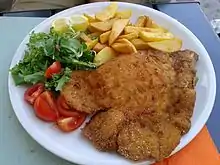Milanesa
The milanesa is a South American variation of cotoletta, or schnitzel, where generic types of meat breaded cutlet preparations are known as a milanesa.[1]

The milanesa was brought to the Southern Cone by Italian immigrants during the mass emigration that created the Italian diaspora between 1860 and the 1920s. Its name probably reflects an original Milanese preparation, cotoletta alla milanese, which is similar to the Austrian Wiener Schnitzel.[2]
A milanesa consists of a thin slice of beef, chicken, fish, veal, or sometimes pork. Each slice is dipped into beaten eggs, seasoned with salt, and other condiments according to the cook's taste (like parsley and garlic). Each slice is then dipped in bread crumbs (or occasionally flour) and shallow-fried in oil, one at a time. Some people prefer to use very little oil and then bake them in the oven as a healthier alternative. A similar dish is the chicken parmigiana.
Variations
.jpg.webp)


By adding tomato paste, mozzarella cheese, and sometimes ham, a dish called milanesa a la napolitana (Milanese in the Neapolitan style) was created. "Neapolitan" is not named for the city of Naples, but because it was first made and sold in Restaurante Napoli owned by Jorge La Grotta in Argentina in the 1940s.[3][4][5] The dish is sometimes known as súper milanesa or suprema napolitana.[6]
Milanesas are one of the most popular dishes in Argentina and have been described as "one of the quintessential Río de la Plata dishes".[7] They are the legacy of Italian immigrants, who introduced cotoletta alla milanese in the late 19th century and early 20th century.[8] During that time, Argentina experienced a huge European immigration wave, with most immigrants coming from Italy. Milanesas are so ubiquitous to Argentine culture that the country even has a "Day of the Milanesa", celebrated on May 3.[8][9][10]
They are frequently served hot with fried or mashed potatoes; this dish is known as milanesa con papas fritas or milanesa con puré. In Argentina, Paraguay and Uruguay, it is often topped with a fried egg, known as milanesa a caballo (milanesa riding horseback), but omits the tomato sauce.[11][12] They are often eaten cold as a sandwich filling, with salad. Lemon juice and sometimes mayonnaise are commonly used as seasoning.
Milanesa Kaiser, or escalopa as it is known in Chile, is a variant (where normal milanesas are also eaten) reminiscent of cordon bleu or valdostana, with a layer of melted cheese between the beef and a layer of ham. A classic Chilean version is called escalopa a lo pobre, topped with french fries, sautéed onions and fried eggs, akin to lomo a lo pobre.
In Mexico and the Southern United States, milanesas are eaten in some regions, often in a torta (a sandwich made with bolillo or telera bread). In northern Baja California, Sonora, Sinaloa, and Chihuahua (due to U.S influence), it features lettuce, tomato, and mayonnaise like a traditional sandwich, but the milanesa is also common in these regions as the main course of a meal. The milanesa memela napolitana is made with a thick fried tortilla with a milanesa on top, with ham, tomato sauce and grated cheese. In Mexico, milanesa usually refers to the preparation method; any type of meat that is pounded thin, breaded and fried might be referred to as a milanesa. In the northern state of Nuevo León, perhaps due to the influence of German and Czech immigrants, the dish known as milanesa is extremely popular and stands on its own as a main dish in most restaurants. It is usually served with french fries, refried beans, rice, and a lettuce salad.
In Panama, they are most commonly made of thinly sliced beef (usually sirloin steak), but also thin chicken fillet. Lime juice is squeezed over them before serving or eating them, and often they are also seasoned with hot sauce. They are eaten with white rice and other side dishes such as salad, lentils or beans. The latter two are poured over the rice, as they are usually served in Panama while the salad is served off to the side where there is still space left on the plate. When served as sandwiches, they are known as emparedado de milanesa or sandwich de milanesa when tomatoes, onions, lettuce, ketchup, and/or American cheese (queso amarillo i.e. yellow cheese). Pan de molde (sandwich bread) and pan flauta (a Panamanian type of baguette that is thicker and softer) are the types used to make these sandwiches.
In the Philippines, milanesa is known as carne frita, and is cooked in much the same way as described above (meat pounded until thin, flour, egg, breadcrumbs, fried). Admittedly, it is not as popular in the country as it is in South America, and it is served mainly in people's homes, not in restaurants. The families that do eat it usually serve milanesa/carne frita with white rice, a bean stew of some sort (for instance, white beans with a dark leafy green; also fabada), sometimes an American-style potato salad with cut green beans added, and often, chili ketchup and/or a mayo-ketchup mixed sauce not unlike the South American salsa golf. It is almost never served as a sandwich.
See also
- Argentine cuisine
- Austrian cuisine
- Bolivian cuisine
- Brazilian cuisine
- Chilean cuisine
- Italian cuisine
- Mexican cuisine
- Panamanian cuisine
- Paraguayan cuisine
- Peruvian cuisine
- Uruguayan cuisine
- Venezuelan cuisine
Similar dishes:
References
| Wikimedia Commons has media related to Milanesa. |
- Shirley Thomas Brooks (2003). Argentina Cooks: Treasured Recipes from the Nine Regions of Argentina. Hippocrene Books. pp. 51–52. ISBN 9780781809979. Retrieved 3 July 2013.
- The truth of the Milanese Archived 2008-05-27 at the Wayback Machine In Pampa and the road, October 08, 2005. Retrieved on October 09, 2008 (in Spanish)
- Pisarro, Marcelo (2012-05-11). "Milanesa napolitana". Clarín (Argentine newspaper) (in Spanish). Archived from the original on 2014-05-17. Retrieved 2014-05-15.
- "Milanesa a la napolitana". El Reporte (in Spanish). 2013-04-25.
- "El origen de la milanesa". ABC Color (in Spanish). 2013-04-13. Archived from the original on 2014-05-17.
- "SUPREMA NAPOLITANA CON PAPAS FRITAS". cocinerosargentinos.com.
- "Día de la Milanesa: los secretos detrás del imprescindible plato de la cocina porteña" (in Spanish). Infobae. May 3, 2018. Retrieved March 14, 2019.
- "Día de la milanesa: cómo se creó uno de los platos favoritos de los argentinos". Clarín (in Spanish). May 3, 2015. Retrieved March 14, 2019.
- "Los argentinos festejan el Día de la Milanesa". www.lanacion.com.ar (in Spanish). Retrieved 2020-11-01.
- Tribuno, El. "El Tribuno". El Tribuno (in Spanish). Retrieved 2020-11-01.
- "Milanesa a caballo". tasteatlas.com. Retrieved April 12, 2020.
- "Milanesa 'on horseback' with french fries". bodegaargento.com. Retrieved April 12, 2020.